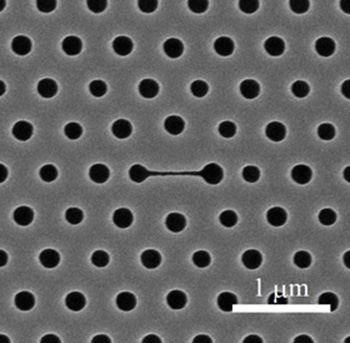
Top view of the nanolaser. The center narrow slot (horizontal line) is the main part of the sensor. The periodic holes form a photonic crystal. Credit: Toshihiko Baba, Yokohama National University
A nanolaser—so small that its cavity looks like a scratch in the lattice of a photonic crystal—is the key component of a sensor that detects the adsorption of biomolecules (Appl. Phys. Lett., doi: 10.1063/1.4904481). Such a device could sense the presence of DNA or other proteins without fluorescent labeling or spectral analysis.
Researchers in engineering professor Toshihiko Baba's group at Yokohama National University (Japan) fabricated a nanolaser within an indium gallium arsenide phosphide (GaInAsP) slab of quantum wells, coated with a 3-nm-thick protective layer of zinc oxide. The tiny laser was pumped with laser pulses at a wavelength of 980 nm, which stimulated laser emission at 1,570 nm. The team measured the device's spectral responses when it was immersed in baths of varying pH, ranging from 2 to 11.
The tiny laser's peak emission decreased as the solution changed from strongly acidic to strongly basic. When the pH of the solution is high, its redox potential forms a Schottky barrier with the negatively charged semiconductor material, thus reducing the emission intensity. In the case of low-pH solutions, the Schottky barrier is lowered and surface recombinations are inhibited.
Finally, the team studied the hybridization of DNA, which is conventionally measured by tagging the target DNA with a fluorescent label before it comes into contact with complementary probe DNA. In the Yokohama experiment, the nanolaser sensor's emission decreased when the target DNA was added to the solution containing probe DNA and the hybrid molecules became adsorbed.
The nanolaser sensor chip may be reusable after its zinc oxide coating is removed and redeposited, although the Yokohama researchers believe such devices will be inexpensive and therefore disposable in practice.
